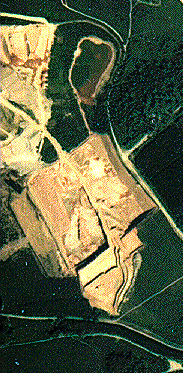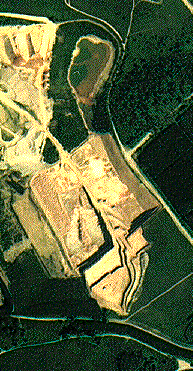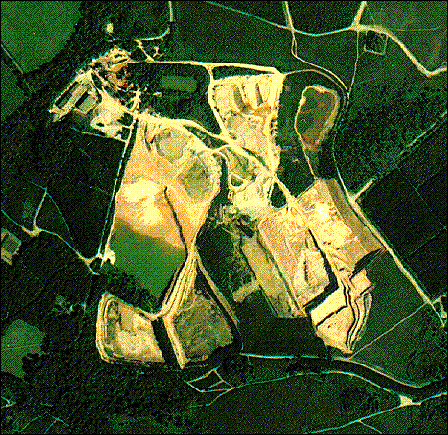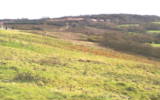
|

|
Blackhill Quarry,
|
These notes are reprinted with kind permission from Camas Aggregates, who used to operate the quarry.
The quarry is currently operated by Aggregate Industries.
The largest quartzite gravel, approximately 12" pebbles down, is found at Blackhill and the Bunter deposit gets smaller as it goes up to the Midlands. The depth of gravel also reduces from its 90 feet at Blackhill down to 6 feet in places.
 The aerial photos on this page were taken in 1991/2 by Geonex (now taken over by NRSC) on behalf of Devon County Council.
The aerial photos on this page were taken in 1991/2 by Geonex (now taken over by NRSC) on behalf of Devon County Council.
The quarry was first operated in the early 1930's by hand digging, sieving and breaking the pebbles into road macadam by hand hammers. This was the practice of at least half a dozen locations on the Common and the 'digs' can still be seen.
Scatter Rock Macadam installed machinery for the excavation and crushing of the quartzite in 1934 and the quarry was worked in a small way until 1953 when the Northcott Group of Quarries took over.
Soon after this Blackhill became part of Western Quarry Sales Limited and in 1958 this company became part of EEC Quarries Limited, a subsidiary of English China Clays. On the 1st June 1995 EEC Quarries then became known as CAMAS Aggregates.
An interesting feature of the early part of the quarry is that Scatter Rock installed a primitive Coated Macadam plant and are thought to have produced the first bitumen bound macadams in Devon on this plant.
The Northcott era saw a new plant installed, some of which is still operating, but in the early 60's coated production was halted and concentrated at neighbouring Rockbeare Hill Quarry.
The present plant was mainly constructed in the early 70's with the installation of a Linatex Sand Plant, Wileman Scrubber, larger elevators and screens and increased crushing capacity.
Present plant consents with controlled excavation and restoration requirements will take us through to the year 2010 at least.

|

|
The quartzite and pebbles are excavated by Poclain 3 yds cubed hydraulic back acter in benches of 20 feet approx. depth. A total depth of 100 feet is worked in some places although in others only 10 feet of gravel is removed. The purpose of this is two-fold: Firstly to preserve the water flow characteristics of the bunter gravel and secondly to leave natural slopes to common land.
The face gravel is hauled to the quarry by 30 ton Aveling Barford dumpers and tipped into the primary hopper.
A variable rate feeder underneath feeds the face gravel onto the primary screen at up to 250 tonnes per hour. Plus 3" material passes through the Hadfield 24" x 13" Jaw Crusher and is reduced to 4" size before rejoining the remainder of the material on the primary conveyor.
All the face gravel is now fed onto a washing screen to remove 3/16" sand and silt, which is pumped to the sand plant, before the +3/16" coarse aggregate is scrubbed clean in the Wileman scrubber.
+3/4" aggregate is crushed through two 3' Symons Crushers and rescreened into three components; Sand which is pumped away, -3/4" rounded concrete aggregate which is screened again on the aggregate plant and +3/4" quartzite, which is the raw material from which will be produced crushed chippings on the tertiary plant.
Two 3' Symons Short Head crushers and three Niagara vibrating screens are incorporated in the tertiary plant and the quartzite is crushed in a closed circuit until it all passes 9/16" size. A considerable tonnage of stone dust is produced in these crushers and this is again pumped back to produce coarse sand.
Two grades of sand are made in the sand plant - coarse for concreting, fine for building purposes and they are separated by a mixture of gravitational and cyclonic methods.
Large ponds and pumps are necessary both to feed the 60,000 gallons of clean water each hour to the plant and to remove the dirty water which contains up to 50 tonnes of silty clay waste each hour, back to the silt ponds.
Aggregates and sands are either loaded direct for sale or stockpiled and rehandled with a Caterpillar 966 3 yds cubed loading shovel.
The Ready Mixed Concrete industry is the largest user of Blackhill's concrete aggregates and sands, although a large tonnage is supplied to builders and contractors direct.
The high quality surface dressing chippings has been supplied as far way as the Isle of Wight, Andover, West Sussex etc., either by road transport or sea via Exmouth (Exmouth are now closed).
The working areas at the face have been carefully chosen to harmonise with the lanscape and will either be left as lakes or backfilled with silt, capped with overburden and afforested or landscped to fit in with the natural scenic beauty of Woodbury Common.
An item of interest is the high cost of equipment and materials necessary to produce quarry products. For example a new hydraulic excavator would cost £250,000 and burn 10 gallons of fuel an hour and our electricity bill averages £1000 per week.
Quartzite is a very hard and abrasive stone - it will even cut glass.
We extract it and it is used for the benefit of society in the construction of schools, houses , roads etc; we then leave the landscape in a condition that is acceptable to that same society so we may all enjoy the continuing beauty of Woodbury Common.
 The quarry from Woodbury Castle - click on the image to see a larger version.
The quarry from Woodbury Castle - click on the image to see a larger version.
Also on the site are Blackhill Engineering Ltd.
| Woodbury Common main menu | British Explorers main menu |
This web site is not responsible for the content of external sites.
This page last updated 25th. September 2014.
Some text © Copyright Jim Batten, 1996-2014.
Majority of text © Copyright CAMAS Aggregates Ltd., 1996.
Aerial photograph © Copyright Devon County Council, 1996.